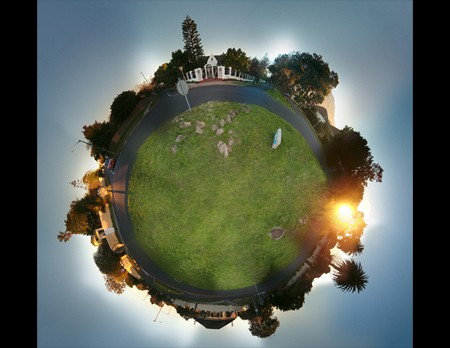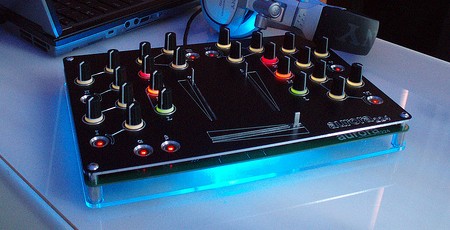
We at Hackaday often dream of having our own personal planets where we wouldn’t have to deal with other people, but our spaceships aren’t quite ready. While we figure that out, you can do the next best thing: render small planets using Photoshop or GIMP with a few other graphics apps and this guide to making small planets like the one pictured above.
Author: Juan Aguilar160 Articles
Lively, Google’s Stab At Second Life

Google has just released their own avatar based social arena a la Second Life, which is called Lively. It will require a client download and install like the popular MUD, but after that it can be accessed via IE and Firefox.
Lively allows user to create their own online spaces that can include natural or human-built settings and customize their avatars (which are relatively cartoonish in comparison to SL avatars). Google’s engineering manager for Lively [Niniane Wang] explains that they wanted to create a more socially rich environment than was possible with emotes and other chatroom features.
Lively’s core functions are not particularly novel, but it does innovate with various web integration features. Videos and images from the internet are viewable from within Lively, and users can embed their own personal Lively areas into their blogs or websites (hello VRML).
Lively is not nearly as expansive as Second Life yet, with no form of currency included and only stock items, clothes, avatars, and geometry to choose from. What’s more, it is only available for Windows XP and Vista, with no other OS support announced. We can see this getting better in the future, but those of you who’s lives are so great that you need a second one (or a third) will probably want to jump on this now.
Major DNS Issue Causes Multivendor Patch Day

Earlier this year, our friend [Dan Kaminsky] discovered a major DNS issue that could allow hackers to compromise name servers and clients easily. The vulnerability involves cache poisoning, and [Kaminsky] plans to publish the full details of the vulnerability on August 6th. However, he has already begun his work to control it, alerting major authorities early on of the vulnerability.
As a result, engineers from many major technology vendors quickly began working on coordinated patches for DNS servers. The patches were all released today; vendors and a CERT advisory urge organizations to apply them today, before the vulnerability becomes common knowledge. More details on the DNS issue can be found in the executive overview (PDF file). [Rich Mogull] interviewed [Dan] for the Network Security Podcast. It doesn’t detail the attack but points out that services that use port randomization like OpenDNS are unaffected and that Bind8 is being deprecated.
UPDATE: Here’s the audio from this morning’s press conference.
[image: Flickr / d70focus ]
Pedal Powered Panzer Tank Built For Crashing Parties

A group from Philadelphia PA calling themselves Team pzkpfw decided to recreate a Panzerkampfwagen III, but not entirely according to the original specs. Instead of treads and an engine, they used a system of pedals, gears and chains powered by up to six riders. The team of roughly nine men spent eleven days welding beams and plates, drilling and shaping sprockets, and painting the tank a fearsome pink camouflage. They were planning on crashing the 2nd annual Kensington Kinetic Sculpture Derby with it, which they crashed last year in a pirate ship, but they ended up being too tired from their tooling around to actually do it. There’s always next year. Get a look at their promotional video after the break, or if you’ll be in the Philly area soon, “visit the tank on Frankford Ave, just north of Norris St in Philadelphia.”
Continue reading “Pedal Powered Panzer Tank Built For Crashing Parties”
Aurora Open Source Hardware Mixer

We’ve seen some fairly impressive mixer projects this year, and the Aurora mixer is no exception. It is a dual channel USB-powered mixer with two linear faders, one crossfader, eight backlit buttons and 24 potentiometers, all built around a PIC 18LF4525 microcontroller. That’s all pretty typical for a mixer, but this one is very visually attractive, featuring a clean and stylish form factor and controllable lighting both under the board and in the LEDs backlighting the buttons and knobs.
Whether you want to buy one now or build one yourself, the Aurora team has made both possible. You can contact them for pricing if you are ready to buy. If you prefer to build, this is an open source project with full assembly instructions, schematics, drivers, patches and all other source code and information you should need available here. See more photos of the Aurora mixer here, or see it in action after the break.
Grizzly Suit Up For Auction

Do you have a burning desire to fight grizzly bears? If you do, We can’t guarantee that the first bear you face will win, but we really can’t imagine another outcome unless you use [Troy Hurtubise]’s Mk IV suit, which is currently up for auction. We have discussed the suit before along with several other high-tech power suits, but this is the only one with bear-resistance in mind. The suit features several safety features, including layers of chainmail and titanium.The suit was also featured in the film “Project Grizzly.” [Hurtubise] is hoping to sell the suit for $40,000 or more to offset his personal costs, and judging by the current price, he may well make it.
[via Engadget]
Wii Nunchuck Used For Mocap On 3D Studio Max

If you’ve been looking for a cheap way to do motion capture on 3D Studio Max, [melka] has devised an ingenious way to do mocap using a Wii nunchuck. As shown in his Vimeo video, the nunchuck is connected to an Arduino that feeds MIDI data to a computer running the MIDI app Ableton Live. Ableton Live feeds that data to 3D Studio Max via MIDI Yoke.
The video below the break shows that the motion of the nunchuck can be seen in real time in the 3D Studio Max Window. We’re really hoping [melka] will post a writeup of this project soon, as we are hungry for more details.
Continue reading “Wii Nunchuck Used For Mocap On 3D Studio Max”










